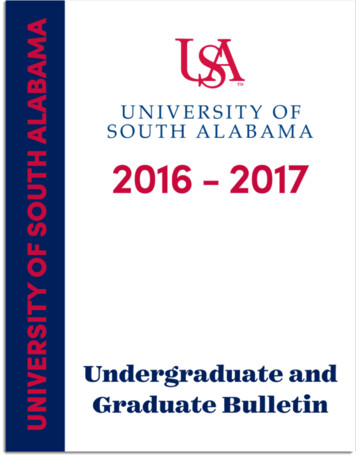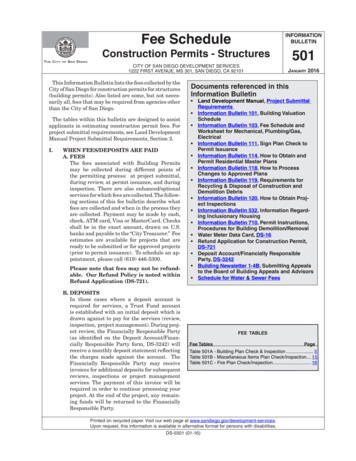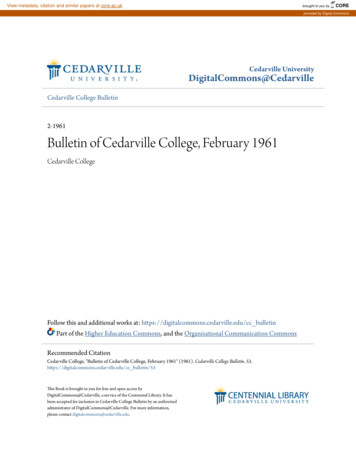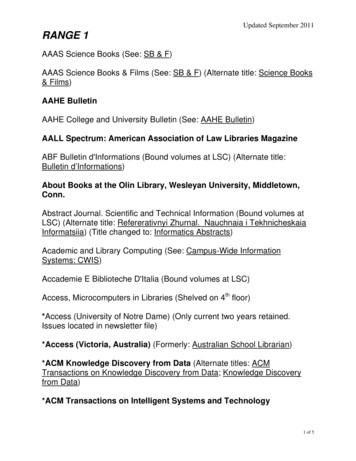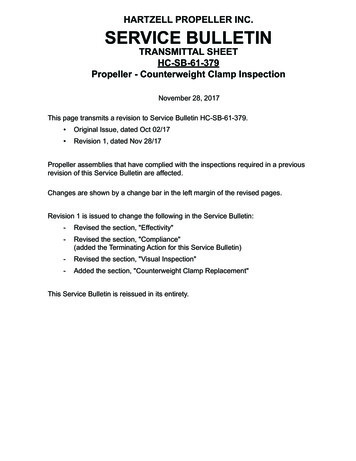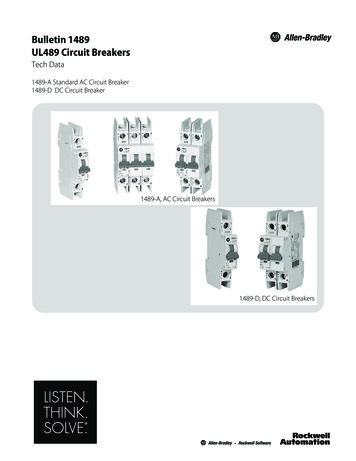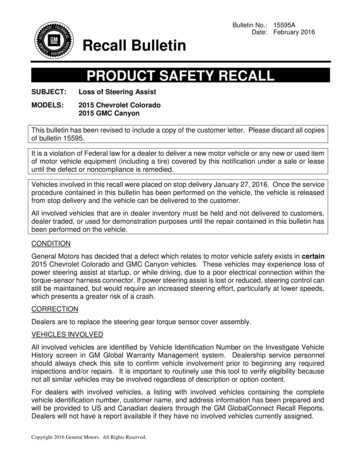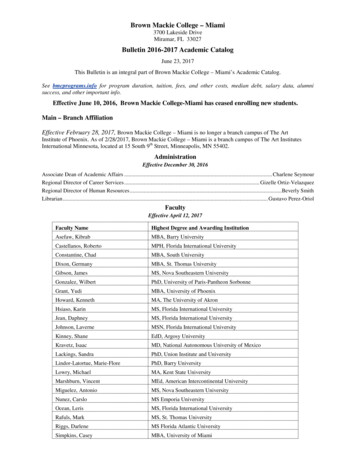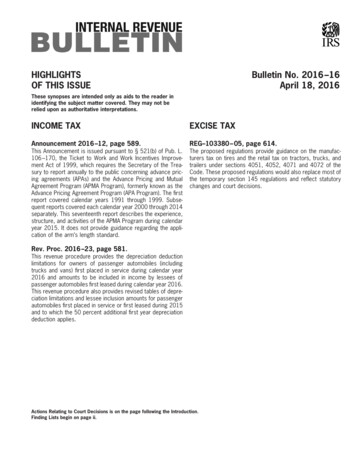
Transcription
HIGHLIGHTSOF THIS ISSUEBulletin No. 2016 –16April 18, 2016These synopses are intended only as aids to the reader inidentifying the subject matter covered. They may not berelied upon as authoritative interpretations.INCOME TAXEXCISE TAXAnnouncement 2016 –12, page 589.REG–103380 – 05, page 614.This Announcement is issued pursuant to § 521(b) of Pub. L.106 –170, the Ticket to Work and Work Incentives Improvement Act of 1999, which requires the Secretary of the Treasury to report annually to the public concerning advance pricing agreements (APAs) and the Advance Pricing and MutualAgreement Program (APMA Program), formerly known as theAdvance Pricing Agreement Program (APA Program). The firstreport covered calendar years 1991 through 1999. Subsequent reports covered each calendar year 2000 through 2014separately. This seventeenth report describes the experience,structure, and activities of the APMA Program during calendaryear 2015. It does not provide guidance regarding the application of the arm’s length standard.The proposed regulations provide guidance on the manufacturers tax on tires and the retail tax on tractors, trucks, andtrailers under sections 4051, 4052, 4071 and 4072 of theCode. These proposed regulations would also replace most ofthe temporary section 145 regulations and reflect statutorychanges and court decisions.Rev. Proc. 2016 –23, page 581.This revenue procedure provides the depreciation deductionlimitations for owners of passenger automobiles (includingtrucks and vans) first placed in service during calendar year2016 and amounts to be included in income by lessees ofpassenger automobiles first leased during calendar year 2016.This revenue procedure also provides revised tables of depreciation limitations and lessee inclusion amounts for passengerautomobiles first placed in service or first leased during 2015and to which the 50 percent additional first year depreciationdeduction applies.Actions Relating to Court Decisions is on the page following the Introduction.Finding Lists begin on page ii.
The IRS MissionProvide America’s taxpayers top-quality service by helpingthem understand and meet their tax responsibilities and enforce the law with integrity and fairness to all.IntroductionThe Internal Revenue Bulletin is the authoritative instrument ofthe Commissioner of Internal Revenue for announcing officialrulings and procedures of the Internal Revenue Service and forpublishing Treasury Decisions, Executive Orders, Tax Conventions, legislation, court decisions, and other items of generalinterest. It is published weekly.It is the policy of the Service to publish in the Bulletin allsubstantive rulings necessary to promote a uniform applicationof the tax laws, including all rulings that supersede, revoke,modify, or amend any of those previously published in theBulletin. All published rulings apply retroactively unless otherwise indicated. Procedures relating solely to matters of internalmanagement are not published; however, statements of internal practices and procedures that affect the rights and dutiesof taxpayers are published.Revenue rulings represent the conclusions of the Service onthe application of the law to the pivotal facts stated in therevenue ruling. In those based on positions taken in rulings totaxpayers or technical advice to Service field offices, identifying details and information of a confidential nature are deletedto prevent unwarranted invasions of privacy and to comply withstatutory requirements.Rulings and procedures reported in the Bulletin do not have theforce and effect of Treasury Department Regulations, but theymay be used as precedents. Unpublished rulings will not berelied on, used, or cited as precedents by Service personnel inthe disposition of other cases. In applying published rulings andprocedures, the effect of subsequent legislation, regulations,court decisions, rulings, and procedures must be considered,and Service personnel and others concerned are cautionedagainst reaching the same conclusions in other cases unlessthe facts and circumstances are substantially the same.The Bulletin is divided into four parts as follows:Part I.—1986 Code.This part includes rulings and decisions based on provisions ofthe Internal Revenue Code of 1986.Part II.—Treaties and Tax Legislation.This part is divided into two subparts as follows: Subpart A, TaxConventions and Other Related Items, and Subpart B, Legislation and Related Committee Reports.Part III.—Administrative, Procedural, and Miscellaneous.To the extent practicable, pertinent cross references to thesesubjects are contained in the other Parts and Subparts. Alsoincluded in this part are Bank Secrecy Act Administrative Rulings. Bank Secrecy Act Administrative Rulings are issued bythe Department of the Treasury’s Office of the Assistant Secretary (Enforcement).Part IV.—Items of General Interest.This part includes notices of proposed rulemakings, disbarment and suspension lists, and announcements.The last Bulletin for each month includes a cumulative index forthe matters published during the preceding months. Thesemonthly indexes are cumulated on a semiannual basis, and arepublished in the last Bulletin of each semiannual period.The contents of this publication are not copyrighted and may be reprinted freely. A citation of the Internal Revenue Bulletin as the source would be appropriate.April 18, 2016Bulletin No. 2016 –16
Actions Relating to Decisions of the Tax CourtIt is the policy of the Internal RevenueService to announce at an early datewhether it will follow the holdings in certain cases. An Action on Decision is thedocument making such an announcement.An Action on Decision will be issued atthe discretion of the Service only on unappealed issues decided adverse to thegovernment. Generally, an Action on Decision is issued where its guidance wouldbe helpful to Service personnel workingwith the same or similar issues. Unlike aTreasury Regulation or a Revenue Ruling,an Action on Decision is not an affirmative statement of Service position. It is notintended to serve as public guidance andmay not be cited as precedent.Actions on Decisions shall be reliedupon within the Service only as conclusions applying the law to the facts in theparticular case at the time the Action onDecision was issued. Caution should beexercised in extending the recommendation of the Action on Decision to similarcases where the facts are different. Moreover, the recommendation in the Actionon Decision may be superseded by newlegislation, regulations, rulings, cases, orActions on Decisions.Prior to 1991, the Service publishedacquiescence or nonacquiescence only incertain regular Tax Court opinions. TheService has expanded its acquiescenceprogram to include other civil tax caseswhere guidance is determined to be helpful. Accordingly, the Service now mayacquiesce or nonacquiesce in the holdingsof memorandum Tax Court opinions, aswell as those of the United States DistrictCourts, Claims Court, and Circuit Courtsof Appeal. Regardless of the court deciding the case, the recommendation of anyAction on Decision will be published inthe Internal Revenue Bulletin.The recommendation in every Actionon Decision will be summarized as acquiescence, acquiescence in result only, or nonacquiescence. Both “acquiescence” and “acquiescence in result only” mean that theService accepts the holding of the court in acase and that the Service will follow it indisposing of cases with the same controllingfacts. However, “acquiescence” indicatesneither approval nor disapproval of the reasons assigned by the court for its conclusions; whereas, “acquiescence in resultonly” indicates disagreement or concernwith some or all of those reasons. “Nonac-quiescence” signifies that, although no further review was sought, the Service does notagree with the holding of the court and,generally, will not follow the decision indisposing of cases involving other taxpayers. In reference to an opinion of a circuitcourt of appeals, a “nonacquiescence” indicates that the Service will not follow theholding on a nationwide basis. However, theService will recognize the precedential impact of the opinion on cases arising withinthe venue of the deciding circuit.The Actions on Decisions published inthe weekly Internal Revenue Bulletin areconsolidated semiannually and appear inthe first Bulletin for July and the Cumulative Bulletin for the first half of the year.A semiannual consolidation also appearsin the first Bulletin for the following January and in the Cumulative Bulletin forthe last half of the year.The Commissioner does NOTACQUIESCE in the following decision:Cosentino v. Commissioner,T.C. Memo. 2014 –186,11Nonacquiescence relating to the holding that an amount the taxpayers received, to settle a claim that they incurred additional income tax liability because of the tax professional’s advicethat they enter into an abusive tax shelter, is excludible from their gross income as a restoration of lost capital.April 18, 2016580Bulletin No. 2016 –16
Part III. Administrative, Procedural, and Miscellaneous26 CFR 601.105: Examination of returns and claimsfor refund, credit, or abatement; determination ofcorrect tax liability.(Also: Part I, §§ 280F; 1.280F–7.)Rev. Proc. 2016 –23SECTION 1. PURPOSEThis revenue procedure provides: (1)limitations on depreciation deductions forowners of passenger automobiles firstplaced in service by the taxpayer duringcalendar year 2016, including separate tables of limitations on depreciation deductions for trucks and vans; (2) amounts thatmust be included in income by lessees ofpassenger automobiles first leased by thetaxpayer during calendar year 2016, including a separate table of inclusionamounts for lessees of trucks and vans;and (3) revised tables of depreciation limitations and lessee inclusion amounts forpassenger automobiles that were first placed inservice or first leased by the taxpayer, respectively, during 2015 and to which the 50percent additional first year depreciation deduction under § 168(k)(1)(A) of the InternalRevenue Code applies as extended by§ 143(a) of the Protecting Americans fromTax Hikes Act of 2015 (the Act), enacted aspart of the Consolidated AppropriationsAct, 2016, Division Q, Pub. L. No. 114 –113, 129 Stat. 2242 (December 18, 2015).The tables detailing these depreciation limitations and lessee inclusion amounts reflectthe automobile price inflation adjustmentsrequired by § 280F(d)(7).SECTION 2. BACKGROUND.01 For owners of passenger automobiles, § 280F(a) imposes dollar limitationson the depreciation deduction for the yearthe taxpayer places the passenger automobile in service and for each succeedingyear. For passenger automobiles placed inservice after 1988, § 280F(d)(7) requiresthe Internal Revenue Service to increasethe amounts allowable as depreciation deductions by a price inflation adjustmentamount. The method of calculating thisprice inflation amount for trucks and vansplaced in service in or after calendar year2003 uses a different CPI “automobilecomponent” (the “new trucks” component) than that used in the price inflationBulletin No. 2016 –16amount calculation for other passengerautomobiles (the “new cars” component),resulting in somewhat higher depreciationdeductions for trucks and vans. Thischange reflects the higher rate of priceinflation for trucks and vans since 1988.02 Section 168(k)(1) provides that, inthe case of qualified property, the depreciation deduction allowed under § 167(a)for the taxable year in which the propertyis placed in service includes an allowanceequal to 50 percent of the property’s adjusted basis (hereinafter, referred to as“§ 168(k) additional first year depreciation deduction”). Prior to the Act,§ 168(k)(1) did not apply to property generally placed in service after December31, 2014. Section 143(b) of the Act extended the § 168(k) additional first yeardepreciation deduction to qualified property (as defined in § 168(k)(2) after theamendments made by § 143(b)(1) of theAct) placed in service by the taxpayerafter December 31, 2015, and generallybefore January 1, 2020. The § 168(k) additional first year depreciation deductionpercentage is 50 percent for qualifiedproperty placed in service during calendaryear 2016. Section 168(k)(2)(F)(i) and(iii), as amended by § 143(b)(1) of theAct, increase the first year depreciationallowed under § 280F(a)(1)(A)(i) by 8,000 for passenger automobiles placedin service by the taxpayer before January1, 2018, and to which the § 168(k) additional first year depreciation deductionapplies.03 Tables 1 through 4 of this revenueprocedure provide depreciation limitations for passenger automobiles placed inservice during calendar year 2016. Table 1(passenger automobiles that are not trucksor vans) and Table 2 (trucks and vans)provide depreciation limitations for passenger automobiles for which the § 168(k)additional first year depreciation deduction, as amended by § 143(b) of the Act,applies. Table 3 (passenger automobilesthat are not trucks or vans) and Table 4(trucks and vans) provide depreciationlimitations for passenger automobiles forwhich the § 168(k) additional first yeardepreciation deduction, as amended by§ 143(b) of the Act, does not apply. The§ 168(k) additional first year depreciation581deduction, as amended by § 143(b) of theAct, does not apply for 2016 if the taxpayer: (1) acquired the passenger automobile used; (2) did not use the passengerautomobile during 2016 more than 50 percent for business purposes; (3) elected outof the § 168(k) additional first year depreciation deduction pursuant to § 168(k)(7),as added by § 143(b)(6)(D) of the Act; or(4) elected to increase the alternative minimum tax (AMT) credit limitation under§ 53, instead of claiming the § 168(k)additional first year depreciation deduction, for qualified property placed in service during 2016 pursuant to § 168(k)(4),as amended by § 143(b)(3) of the Act.04 Section 280F(c) requires a reduction in the deduction allowed to the lesseeof a leased passenger automobile. The reduction must be substantially equivalentto the limitations on the depreciation deductions imposed on owners of passengerautomobiles. Under § 1.280F–7(a) of theIncome Tax Regulations, this reductionrequires a lessee to include in gross income an amount determined by applying aformula to the amount obtained from atable. Table 5 applies to lessees of passenger automobiles that are not trucks andvans and Table 6 applies to lessees oftrucks and vans. Each table shows inclusion amounts for a range of fair marketvalues for each taxable year after the passenger automobile is first leased.05 Section 143(a) of the Act extendedthe 50-percent additional first year depreciation deduction under § 168(k) to qualified property (as defined in § 168(k)(2))acquired by the taxpayer after December31, 2007, and before January 1, 2016, ifno written binding contract for the acquisition of the property existed before January 1, 2008, and if the taxpayer placesthe property in service generally beforeJanuary 1, 2016. Section 168(k)(2)(F)(i)increases the first year depreciation allowed under § 280F(a)(1)(A)(i) by 8,000for passenger automobiles to which the§ 168(k) additional first year depreciationdeduction applies. Accordingly, Tables 7and 8 of this revenue procedure updateRev. Proc. 2015–19, 2015– 8 I.R.B. 656,by providing revised depreciation limitations for passenger automobiles placed inservice during calendar year 2015 forApril 18, 2016
which the § 168(k) additional first yeardepreciation deduction, as extended by§ 143(a) of the Act, applies. This revenueprocedure also updates the lease inclusionamounts in Tables 3 and 4 of Rev. Proc.2015–19 for passenger automobiles firstleased by the taxpayer in calendar year2015.SECTION 3. SCOPE.01 The limitations on depreciation deductions in section 4.01(2) of this revenueprocedure apply to passenger automobiles(other than leased passenger automobiles)that are placed in service by the taxpayerin calendar year 2016, and continue toapply for each taxable year that the passenger automobile remains in service.02 The tables in section 4.02 of thisrevenue procedure apply to leased passenger automobiles for which the lease termbegins during calendar year 2016. Lesseesof these passenger automobiles must usethese tables to determine the inclusionamount for each taxable year duringwhich the passenger automobile is leased.See Rev. Proc. 2011–21, 2011–12 I.R.B.560, for passenger automobiles first leasedduring calendar year 2011; Rev. Proc.2012–23, 2012–14 I.R.B. 712, for passenger automobiles first leased during calendar year 2012; Rev. Proc. 2013–21,2013–12 I.R.B. 660, for passenger automobiles first leased during calendar year2013; Rev. Proc. 2014 –21, 2014 –11I.R.B. 641, as amplified and modified bysection 4.03 of Rev. Proc. 2015–19,2015– 8 I.R.B. 656, for passenger automobiles first leased during calendar year2014; and Rev. Proc. 2015–19, as amplified and modified by section 4.03 of thisrevenue procedure, for passenger automobiles first leased during calendar year2015.SECTION 4. APPLICATION.01 Limitations on DepreciationDeductions for Certain Automobiles.(1) Amount of the inflation adjustment.(a) Passenger automobiles (other thantrucks or vans). Under § 280F(d)(7)(B)(i),the automobile price inflation adjustmentfor any calendar year is the percentage (ifany) by which the CPI automobile component for October of the preceding calendar year exceeds the CPI automobilecomponent for October 1987. Section280F(d)(7)(B)(ii) defines the term “CPIautomobile component” as the automobilecomponent of the Consumer Price Indexfor all Urban Consumers published by theDepartment of Labor. The new car component of the CPI was 115.2 for October1987 and 143.516 for October 2015. TheOctober 2015 index exceeded the October1987 index by 28.316. Therefore, the automobile price inflation adjustment for2016 for passenger automobiles (otherthan trucks and vans) is 24.6 percent(28.316/115.2 x 100%). The dollar limitations in § 280F(a) are multiplied by afactor of 0.246, and the resulting increases, after rounding to the nearest 100, are added to the 1988 limitations togive the depreciation limitations applicable to passenger automobiles (other thantrucks and vans) for calendar year 2016.This adjustment applies to all passengerautomobiles (other than trucks and vans)that are first placed in service in calendaryear 2016.(b) Trucks and vans. To determine thedollar limitations for trucks and vans firstplaced in service during calendar year2016, the Service uses the new truck component of the CPI instead of the new carcomponent. The new truck component ofthe CPI was 112.4 for October 1987 and155.035 for October 2015. The October2015 index exceeded the October 1987index by 42.635. Therefore, the automobile price inflation adjustment for 2016 fortrucks and vans is 37.9 percent (42.635/112.4 x 100%). The dollar limitations in§ 280F(a) are multiplied by a factor of0.379, and the resulting increases, afterrounding to the nearest 100, are added tothe 1988 limitations to give the depreciation limitations for trucks and vans. Thisadjustment applies to all trucks and vansthat are first placed in service in calendaryear 2016.(2) Amount of the limitation. Tables 1through 4 contain the dollar amount of thedepreciation limitation for each taxableyear for passenger automobiles a taxpayerplaces in service in calendar year 2016.Use Table 1 for a passenger automobile(other than a truck or van), and Table 2 fora truck or van, placed in service in calendar year 2016 for which the § 168(k)additional first year depreciation deduction applies. Use Table 3 for a passengerautomobile (other than a truck or van),and Table 4 for a truck or van, placed inservice in calendar year 2016 for whichthe § 168(k) additional first year depreciation deduction does not apply.REV. PROC. 2016–23 TABLE 1DEPRECIATION LIMITATIONS FOR PASSENGER AUTOMOBILES (THAT ARE NOT TRUCKS OR VANS)PLACED IN SERVICE IN CALENDAR YEAR 2016 FOR WHICH THE § 168(k) ADDITIONAL FIRST YEARDEPRECIATION DEDUCTION APPLIESTax Year1st Tax Year2nd Tax Year3rd Tax YearEach Succeeding YearApril 18, 2016Amount 11,160 5,100 3,050 1,875582Bulletin No. 2016 –16
REV. PROC. 2016–23 TABLE 2DEPRECIATION LIMITATIONS FOR TRUCKS AND VANS PLACED IN SERVICE IN CALENDAR YEAR 2016FOR WHICH THE § 168(k) ADDITIONAL FIRST YEAR DEPRECIATION DEDUCTION APPLIESTax Year1st Tax Year2nd Tax Year3rd Tax YearEach Succeeding YearAmount 11,560 5,700 3,350 2,075REV. PROC. 2016–23 TABLE 3DEPRECIATION LIMITATIONS FOR PASSENGER AUTOMOBILES (THAT ARE NOT TRUCKS OR VANS)PLACED IN SERVICE IN CALENDAR YEAR 2016 FOR WHICH THE § 168(k) ADDITIONAL FIRST YEAR DEPRECIATION DEDUCTION DOES NOT APPLYTax Year1st Tax Year2nd Tax Year3rd Tax YearEach Succeeding YearAmount 3,160 5,100 3,050 1,875REV. PROC. 2016–23 TABLE 4DEPRECIATION LIMITATIONS FOR TRUCKS AND VANS PLACED IN SERVICE IN CALENDAR YEAR 2016FOR WHICH THE § 168(k) ADDITIONAL FIRST YEAR DEPRECIATION DEDUCTION DOES NOT APPLYTax Year1st Tax Year2nd Tax Year3rd Tax YearEach Succeeding Year.02 Inclusions in Income of Lessees ofPassenger Automobiles.A taxpayer must follow the proceduresin § 1.280F–7(a) for determining the in-Amount 3,560 5,700 3,350 2,075clusion amounts for passenger automobiles first leased in calendar year 2016. Inapplying these procedures, lessees of passenger automobiles other than trucks andvans should use Table 5 of this revenueprocedure, while lessees of trucks andvans should use Table 6 of this revenueprocedure.REV. PROC. 2016–23 TABLE 5DOLLAR AMOUNTS FOR PASSENGER AUTOMOBILES (THAT ARE NOT TRUCKS OR VANS) WITH A LEASETERM BEGINNING IN CALENDAR YEAR 2016Fair Market Value ofPassenger AutomobileTax Year During LeaseOverNot Over1st2nd3rd4th5th & later 19,00019,50020,00020,500 3327303539Bulletin No. 2016 –16583April 18, 2016
REV. PROC. 2016–23 TABLE 5DOLLAR AMOUNTS FOR PASSENGER AUTOMOBILES (THAT ARE NOT TRUCKS OR VANS) WITH A LEASETERM BEGINNING IN CALENDAR YEAR 2016Fair Market Value ofPassenger AutomobileTax Year During LeaseOverNot Over1st2nd3rd4th5th & 2320328336345352364April 18, 2016584Bulletin No. 2016 –16
REV. PROC. 2016–23 TABLE 5DOLLAR AMOUNTS FOR PASSENGER AUTOMOBILES (THAT ARE NOT TRUCKS OR VANS) WITH A LEASETERM BEGINNING IN CALENDAR YEAR 2016Fair Market Value ofPassenger AutomobileTax Year During LeaseOverNot Over1st2nd3rd4th5th & 0230,000240,000and 01,6111,6921,7731,854REV. PROC. 2016–23 TABLE 6DOLLAR AMOUNTS FOR TRUCKS AND VANS WITH A LEASE TERM BEGINNING IN CALENDAR YEAR 2016Fair Market Valueof Truck or VanTax Year During LeaseOverNot Over1st2nd3rd4th5th & later 19,50020,00020,50021,00021,500 202314172125281620252832Bulletin No. 2016 –16585April 18, 2016
REV. PROC. 2016–23 TABLE 6DOLLAR AMOUNTS FOR TRUCKS AND VANS WITH A LEASE TERM BEGINNING IN CALENDAR YEAR 2016Fair Market Valueof Truck or VanTax Year During LeaseOverNot Over1st2nd3rd4th5th & 57265273281290298305314321330338350366383399April 18, 2016586Bulletin No. 2016 –16
REV. PROC. 2016–23 TABLE 6DOLLAR AMOUNTS FOR TRUCKS AND VANS WITH A LEASE TERM BEGINNING IN CALENDAR YEAR 2016Fair Market Valueof Truck or VanTax Year During LeaseOverNot Over1st2nd3rd4th5th & 0210,000220,000230,000240,000and 4351,5161,5971,6781,7591,839.03 Revised Amounts for PassengerAutomobiles Placed in Service During2015.(1) Calculation of the Revised Amount.The revised depreciation limits providedin this section 4.03 were calculated byincreasing the existing limitations on thefirst year allowance in Rev. Proc.2015–19 by 8,000 as provided in§ 168(k)(2)(F)(i).Bulletin No. 2016 –16(2) Amount of the Revised Limitation.For passenger automobiles (that are nottrucks or vans) placed in service by thetaxpayer in calendar year 2015 for whichthe § 168(k) additional first year depreciation deduction applies, Table 7 of thisrevenue procedure contains the reviseddollar amount of the depreciation limitations for each taxable year. For trucks orvans placed in service by the taxpayer incalendar year 2015 for which the § 168(k)587additional first year depreciation deduction applies, Table 8 of this revenue procedure contains the revised dollar amountof the depreciation limitations for eachtaxable year. If the § 168(k) additionalfirst year depreciation deduction does notapply to a passenger automobile placed inservice by the taxpayer in calendar year2015, the depreciation limitations for eachtaxable year in Tables 1 and 2 of Rev.Proc. 2015–19 apply.April 18, 2016
REV. PROC. 2016–23 TABLE 7DEPRECIATION LIMITATIONS FOR PASSENGER AUTOMOBILES (THAT ARE NOT TRUCKS OR VANS)PLACED IN SERVICE IN CALENDAR YEAR 2015 FOR WHICH THE § 168(k) ADDITIONAL FIRST YEAR DEPRECIATION DEDUCTION APPLIESTax Year1st Tax Year2nd Tax Year3rd Tax YearEach Succeeding YearAmount 11,160 5,100 3,050 1,875REV. PROC. 2016–23 TABLE 8DEPRECIATION LIMITATIONS FOR TRUCKS AND VANS PLACED IN SERVICE IN CALENDAR YEAR 2015FOR WHICH THE § 168(k) ADDITIONAL FIRST YEAR DEPRECIATION DEDUCTION APPLIESTax Year1st Tax Year2nd Tax Year3rd Tax YearEach Succeeding Year(3) Modification to lease inclusionamounts for 2015. The lease inclusionamounts in Tables 3 and 4 of Rev. Proc.2015–19 are modified by striking the firstthree lines of inclusion amounts in Table 3and the first two lines of inclusionamounts in Table 4. Consequently, Table3 of Rev. Proc. 2015–19 applies to passenger automobiles (other than trucks andvans) that are first leased by the taxpayerin calendar year 2015 with a fair marketvalue over 19,000, and Table 4 of Rev.Proc. 2015–19 applies to trucks and vansthat are first leased by the taxpayer incalendar year 2015 with a fair marketvalue over 19,500.April 18, 2016Amount 11,460 5,600 3,350 1,975SECTION 5. EFFECTIVE DATEThis revenue procedure, with the exception of section 4.03, applies to passenger automobiles that a taxpayer firstplaces in service or first leases during calendar year 2016. Section 4.03 of this revenue procedure applies to passenger automobiles that a taxpayer first places inservice or first leases during calendar year2015.SECTION 7. DRAFTINGINFORMATIONThe principal author of this revenueprocedure is Bernard P. Harvey of theOffice of Associate Chief Counsel (Income Tax & Accounting). For furtherinformation regarding this revenue procedure, contact Mr. Harvey at (202) 3177005 (not a toll-free number).SECTION 6. EFFECT
Rev. Proc. 2016-23, page 581. This revenue procedure provides the depreciation deduction limitations for owners of passenger automobiles (including trucks and vans) first placed in service during calendar year 2016 and amounts to be included in income by lessees of passenger automobiles first leased during calendar year 2016.

